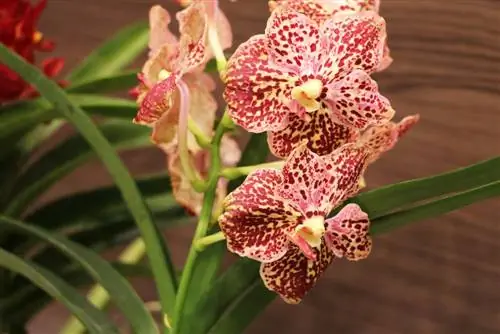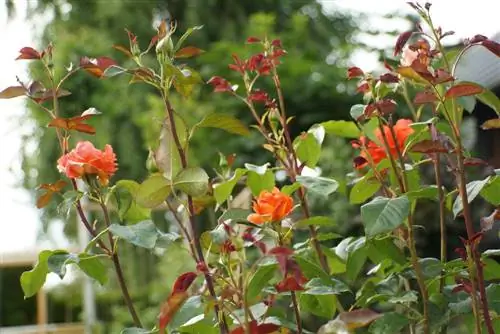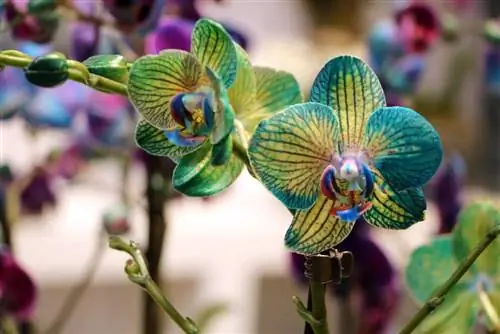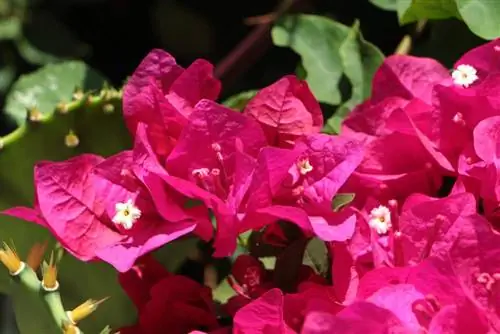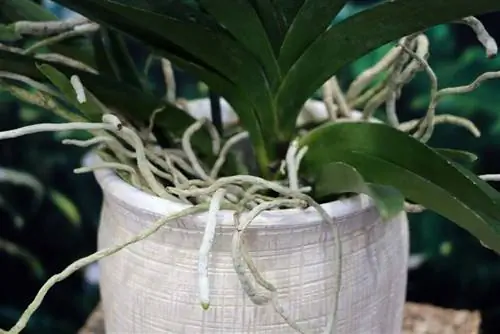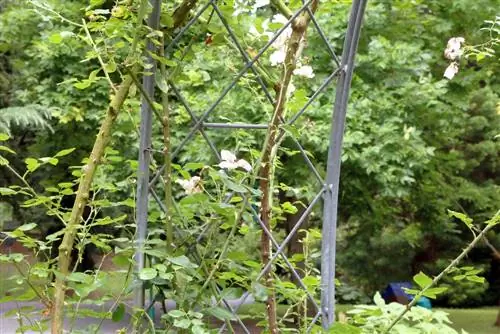- Author admin [email protected].
- Public 2023-12-17 03:39.
- Last modified 2025-01-24 12:45.
The Vanda orchids impress with their beautiful, mostly brightly colored and large flowers. The blue-flowered varieties are often available to buy in garden centers. Their native area is Southeast Asia, where they grow epiphytically on trees. When grown indoors, their flowers can last up to six weeks or even longer. They can bloom up to two or three times a year if properly cared for. In order for them to bloom again quickly, they not only need a lot of sunlight, but also full attention in terms of humidity and fertilizer at the right time.
Location
Vanda orchids need a lot of light so that they keep producing new flowers. However, they do not tolerate strong midday sun very well, as their leaves can then burn. Therefore, depending on the location, shading is necessary during strong sunlight during the midday hours. However, when the Orchidaceae are dark, they only produce leaves. Unfortunately you will be denied flowers. Therefore, always make sure your orchid is in a bright location. The plants also need high humidity, which should be between 60% and 90%. Temperatures should be between 20 and 25 °C during the day in the summer months.
Staying outdoors
In summer, Vanda loves to stand in the garden or on the terrace. This stimulates rapid flowering. When setting up the plant, however, you should make sure that it is in a bright place where it is protected from the midday sun as well as from cold weather and constant rain. As long as the temperature does not drop below 12 °C at night, this orchid can be left outside permanently in summer. The ability of plants to bloom is influenced very positively by the nightly temperature drop and constant air circulation. As soon as the nights get cooler, around September, bring the plant back into the house.
Cultural opportunities
In the glass vase:
Vanda orchids are often offered in hardware stores in glass vases or glass cylinders. The high humidity that they need for growth and flower formation can be maintained better there. However, the plants need a mist of water once a day. Of course it is also possible to immerse them in water. Some lovers of this type of orchid cultivate them in glass cylinders with a layer of pebbles. Using a professional misting system, an appropriate water reservoir and a time control, water mist is blown in four to five times a day, which can be easily distributed throughout the vessel. Fertilizer is added to the water mist every one to two months.
Tip:
If you put the orchid in a water bath so that its roots can soak up, only leave the plant in it for about 10 minutes. Also make sure that when you mist water frequently, no water collects on the roots in the glass, otherwise they can rot.
In the basket
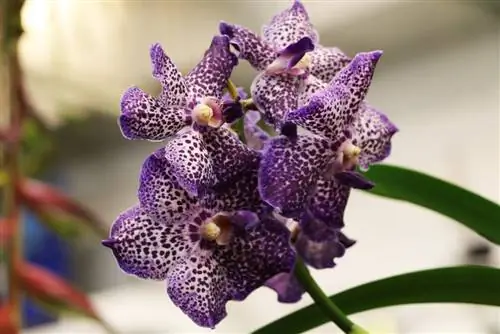
This type of orchid can also be kept in a basket made of slats. The substrate should be a very coarse bark substrate, such as pest-free and well-dried pine bark mixed with a pinch of charcoal. This airy substrate stores water and releases its moisture bit by bit to the roots. The water cannot evaporate as quickly. If you keep the Vanda in a basket, you should transplant the plant every 2 to 3 years, as the bark material gradually decomposes and its coarse structure dissolves. However, the orchids need air at their roots and therefore must not be completely covered with substrate. The new basket should be large enough so that the roots have enough space. Before transplanting, place the orchid in water for about 15 minutes. This means that the sensitive roots become a little more flexible and do not break as easily when placed in the basket. To prevent the pine bark substrate from falling through, you can place a piece of coconut mat in the basket. Then insert the orchid and fill everything with substrate. So that the plant can take root in peace, tie it to stakes that are anchored in the substrate.
Tip:
But don't keep the substrate too wet so that the vanda's roots don't rot. The orchid roots need enough air. Therefore, the roots must always be able to dry well between moistenings. If they are always surrounded by water, they cannot breathe.
Hanging on the window or ceiling
You can also hang the Vanda on the ceiling or on a window. The prerequisite is that the orchid receives enough light there so that it can bloom again quickly. However, midday sun should be avoided. With this type of cultivation, the plant needs to be sprayed with water even more often because the roots dry out very quickly. This means that you need a lot of time during the day for this houseplant.
Do not use colored planters
The roots of orchids need a lot of light. The necessary incidence of light would be prevented by colored planters. In addition to the unobstructed incidence of light, transparent glass vessels or coarse baskets have another positive effect: there is chlorophyll in the green aerial roots of the plant. This substance is responsible for photosynthesis in plants. You can easily see how your orchid is doing from the roots. Once the roots are watered, they turn green. As soon as they need water again, they look silvery. You wouldn't be able to see this in colorful planters, but you would be able to see it in a glass or basket.
Fertilize
So that the pretty orchids can bloom again quickly, they must be fertilized regularly in summer. A commercially available orchid fertilizer is sufficient.
- every 14 days with normal concentration
- or weekly with half concentration
- Observe the manufacturer’s instructions for use
Regular spraying
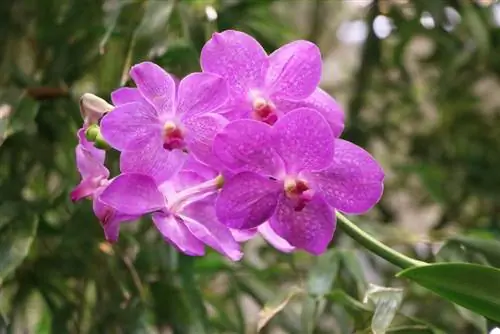
The roots of these plants are like sponges and quickly absorb a lot of moisture. No matter which culture you cultivate your orchid in, it always needs a lot of humidity. As a rule, with Vanda orchids it is sufficient to plant them approx. once a week. Place in water for 10 minutes. The plant should then dry well. No water should remain in the leaf axils, otherwise the beautiful orchids will begin to rot.
Cutting
Vanda orchids need to be cut. However, only the withered flower styles. However, it is advisable to wait until the flower shoot has completely dried before cutting after flowering. The shoot is then cut off to a distance of approx. 1 to 2 cm from the main trunk using sharp and disinfected secateurs.
Wintering
The plant does not have a strict rest period, it blooms all year round. In winter it should just be kept a little cooler. Temperatures between 17 and 22 °C are completely sufficient. Low temperatures of 13 °C are also tolerated at times. But the plants shouldn't be kept so cool all the time. In winter, the orchid is not fertilized and sprayed less with water. In late winter it should be slowly acclimated from the low light period to sunny times again. This means that burns will not occur as quickly if the plant can be put out into the fresh air again in summer.
Diseases and pests
If the environment is too cold and wet, the Vanda orchids are easily attacked by fungi and bacteria. For example, the fungus “Thai disease” is dangerous, as it attacks the conductors of plants from below. This leads to leaf and flower drop. In some infected orchids it has already happened that he althy roots form in the upper part of the plant, so that a head cutting can be taken from them. Here you have the chance to cut off the small cutting and grow it further, as well as to manage the care measures for it better so that it is not infected with the fungus.
Conclusion
Caring for Vanda orchids is very time-consuming because they require high humidity and a lot of light. But the effort is worth it, especially in the summer months when the plant likes to be outdoors. You will then be rewarded with new, beautiful flowers from the pretty exotic plant.

